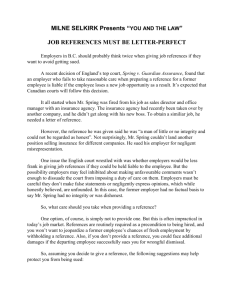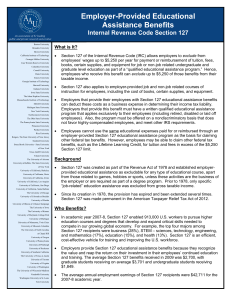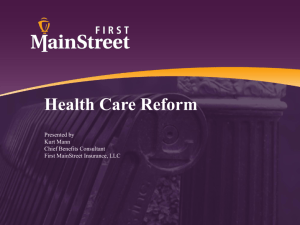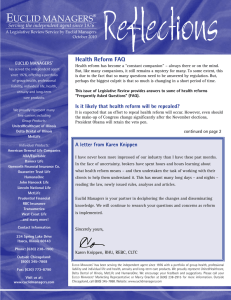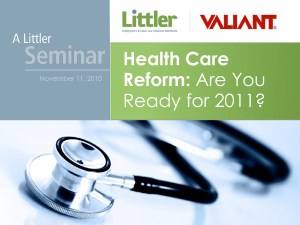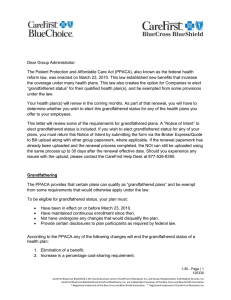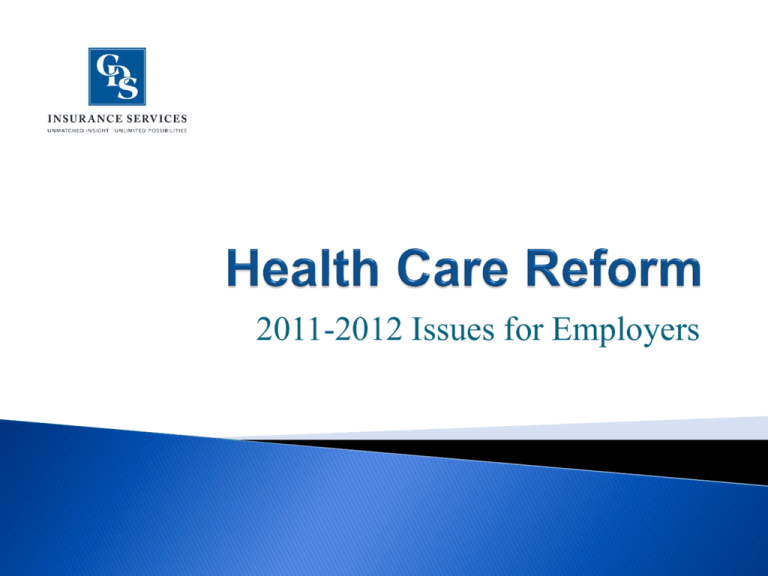
2011-2012 Issues for Employers
How the law affects employers and health plans
Grandfathered plans
Small business tax credit
Early Retiree Reinsurance Program
Plan coverage and administration changes
Employer reporting and disclosure rules
Medical loss ratio (MLR) regulations
CLASS Act
Patient Protection and Affordable Care Act
(PPACA) – signed on March 23, 2010
Health Care and Education Reconciliation Act
(Reconciliation Act) – signed on March 30, 2010
The health care reform law makes sweeping changes
to our nation’s health care system
Existing plans = grandfathered plans
◦ A group health plan or health insurance coverage in which an
individual was enrolled on the date of enactment of the health
care reform legislation
Certain health care reform provisions don’t apply to
grandfathered plans, even if coverage is later renewed
◦ New employees can still enroll
◦ Family members of current enrollees can still join
Regulations provide guidance on changes to plan design
that could take a plan out of “grandfathered” status
Patient Protections
Nondiscrimination rules for fully insured plans
New appeals process
Quality of care reporting
Insurance premium restrictions
Guaranteed issue and renewal of coverage
Nondiscrimination based on health status/in health care
Comprehensive health insurance coverage
Limits on cost-sharing
Coverage for clinical trials
Health Insurance Changes – Prohibitions on:
◦
◦
◦
◦
Lifetime and annual limits
Pre-existing condition exclusions
Rescissions
Excessive waiting periods
Required coverage of adult children up to age 26
Summary of benefits and coverage
Reporting medical loss ratio
Permitted Changes
◦
◦
◦
◦
Cost adjustments consistent with medical inflation
Adding new benefits
Modest adjustments to existing benefits
Voluntarily adopting new consumer protections under the
health care reform law
◦ Changes to comply with state or federal laws
Prohibited Changes
◦
◦
◦
◦
◦
Significantly reducing benefits or contributions
Significantly raising copayment charges or deductibles
Raising coinsurance charges
Adding or tightening annual limits
Changing insurance companies (not TPAs) – Changing
insurers is now permitted!
Special Rule for Insured Collectively Bargained Plans
Additional Requirements
◦ Disclose grandfathered status
◦ Status can be revoked if try to avoid compliance
Changes made before March 23, 2010 are part of the
plan on the date of enactment
◦ Must be legally binding
◦ Changes don’t have to be effective yet
Changes made before regulations issued can be
revoked
◦ Must be adopted before June 14, 2010
◦ Must be revoked by first day of first plan year on or after
September 23, 2010
“Modest changes” may not be taken into account
◦ No clear guidelines
Qualifying small employers that provide health care
coverage to employees are eligible for tax credit
◦ Have fewer than 25 full-time equivalent (FTE) employees
◦ Pay wages averaging less than $50,000 per employee per year
◦ Has a “qualifying arrangement” (pays premiums for each
employee in a uniform percentage that is at least 50 percent of
the cost of coverage)
Available beginning in 2010
IRS guidance clarifies how to calculate FTEs and
wages
Credit based on premiums paid by employer for
health insurance coverage
Credit amount = up to 35 percent of premium
costs paid (25 percent for tax-exempt employers)
◦ On Jan. 1, 2014, increases to 50 percent (35 percent for taxexempt employers)
Depends on employees and wages
◦ The credit phases out gradually for:
Employers with average wages over $25,000 and
Employers with more than 10 FTEs
Plans that are not health insurance coverage:
◦ Self-insured plans (including HRAs and FSAs)
◦ Health Savings Accounts (HSAs)
◦ Employer contributions to these plans are not counted for
credit
Contributions to multi-employer plans can count if
for health insurance coverage
Contributions to church welfare plans count as
insurance
2010 Transition Relief
◦ Employer pays an amount that is equal to at least 50 percent of
the cost of single coverage for each employee enrolled
◦ Even if the percentage paid is not uniform for each employee
2010-2013 Rules
◦ Employer can choose approach for 2010
◦ Qualifying arrangement depends on number of plans and type
of billing (composite or list)
Effective on date of enactment?
◦ Yes, but need regulations so compliance delayed
Large employers that offer health benefits must
automatically enroll new employees
◦ Large employer = more than 200 full-time employees
Adequate notice and opt-out option required
Other questions to be addressed in regulations
Temporary program to reimburse costs of providing
coverage for early retirees, spouses and dependents
Early retiree = 55 and older and not eligible for
Medicare
Reimburses 80 percent of costs related to claims
between $15,000 and $90,000
◦ Must be used to lower plan costs (not for general revenue)
Apply and submit claims to HHS
◦ New application for use after Nov. 9, 2010
Updated information at www.errp.gov
Plans that cover dependent children must make
coverage available until child turns 26
◦ Includes grandfathered plans, unless child has own employer
coverage (before 2014)
◦ Covers married and unmarried children
◦ Children and spouses of covered adult children do not have to
be covered
State mandates above this level continue to apply
Insurers complying early to avoid coverage gaps
Tax exclusion applies to coverage
Definition of dependent restricted
◦ Can only be defined by relationship
◦ Other factors (financial dependence, residency, student status,
employment, eligibility for other coverage) generally can’t be
used as basis for denial
Qualified dependents must be:
◦ Offered same coverage as similarly situated individuals
◦ Given the same rates for coverage
◦ Provided with a 30-day special enrollment opportunity and
notice
Favorable tax treatment extended for this coverage
◦ Coverage excluded from income for children who have not
attained age 27 at the end of the taxable year
◦ Other dependent requirements do not apply
◦ Applies to health FSAs and HRAs
Effective March 30, 2010
Transition rule for cafeteria plan amendments
◦ Retroactive amendment permitted
Apply to new and grandfathered plans
No lifetime limits on essential benefits
Restricted annual limits on essential benefits
◦ Allowed for plan years beginning before Jan. 1, 2014
Essential benefits generally include:
◦ Ambulatory patient services, emergency services, hospitalization, maternity and
newborn care, mental health and substance abuse services, prescription drugs,
rehab services, lab services, wellness and disease management, pediatric care
Per beneficiary limits ok on non-essential benefits
Some regulations issued, waiting on others
Lifetime Limits
◦ Notice and special enrollment required for individuals who
reach lifetime limit
Restricted Annual Limits
◦ After September 23, 2010: $750,000
◦ After September 23, 2011: $1.25 million
◦ After September 23, 2012 (before January 1, 2014): $2 million
Waivers available for annual limit requirements
Plans can apply for waiver of annual limit
minimums if access to or cost of benefits
significantly affected
Plan or policy must have existed before September
23, 2010
◦ Exceptions for certain mandated or group policies
Approval applies for one year
◦ Plans must reapply for later years
If plan obtains a waiver, must notify participants
No rescission of coverage
◦
◦
◦
◦
Applies to group and individual coverage
Applies to new and grandfathered plans
Exception for fraud or intentional material misrepresentation
Individual must be given prior notice of cancellation for
permitted reasons (including nonpayment of premium or plan
termination)
No pre-existing condition exclusions or limitations
for children under age 19
◦ This prohibition will apply to everyone in 2014
◦ Applies to new and grandfathered group plans
Apply to new plans
Limits on preauthorization and cost-sharing
◦ No cost-sharing for some preventive care (including well-child
care) and immunizations
◦ No preauthorization or increased cost-sharing for emergency
services (in- vs. out-of-network)
◦ No preauthorization or referral for ob/gyn care
Patients can chose any available participating
primary care provider (or pediatrician)
Regulations issued
Apply to new fully insured plans
Fully insured plans must follow rules regarding
nondiscrimination in favor of highly compensated
employees (HCE)
◦ Cannot discriminate with respect to eligibility or benefits
HCE:
◦ 5 highest paid officers, more than 10 percent shareholder, or
highest paid 25 percent of all employees
Effective date delayed for regulations
Apply to new plans
Group health plans and health insurers must
implement effective internal appeals process
◦
◦
◦
◦
◦
Include rescissions as denials
Expedite urgent care claims
Provide a full and fair review and avoid conflicts of interest
Follow new notice standards
Continue coverage until appeal is resolved
Grace period until July 1, 2011 for some rules
Plans and insurers must meet minimum requirements
for external review (state or federal)
Some small employers can provide a simple
cafeteria plan for employees
◦ 100 or fewer employees during one of the last 2 years
Strict contribution, eligibility and participation
requirements apply
◦ Employer contributes minimum amount
◦ All employees with 1,000 hours of service can participate and
elect any benefit
Nondiscrimination rules will be treated as satisfied
Apply to Health FSAs, HRAs, HSAs and Archer
MSAs
Medicine or drugs only treated as qualified medical
expense for tax exclusion if they are prescribed or
are insulin
◦ This means no reimbursement for OTC medicine or drugs
without a prescription (except insulin)
Applies to expenses incurred after Dec. 31, 2010
HSA distributions not used for medical expenses
currently subject to tax of 10 percent and inclusion
in gross income
◦ Not monitored by employer
◦ Taxation between employee and IRS
Tax amount increases to 20 percent if funds not used
for medical expenses
Applies to distributions made after December 31,
2010
MLR rules:
◦ Insurers must spend 80-85 percent of premiums on medical
care and quality improvement (not admin. costs) or give
rebates
◦ Effective January 1, 2011
HHS issued final rule
◦ Adopted NAIC recommendations
◦ Outlines items counted as medical care/health care quality
improvement (and items that are not)
◦ Provides rules for rebates
Issuer must provide proportionate rebate to each
enrollee if MLR requirements not met (and notice)
Due by the August 1 after reporting year
Issuer can arrange with group health plans to
distribute rebates to enrollees
Methods of payment
◦ Premium credit
◦ Lump sum check
◦ Reimbursement to account used to pay premium
Employers must disclose aggregate cost of
employer-sponsored health coverage on Forms W-2
Optional for 2011 tax year; mandatory for later tax
years
Includes group health plan coverage, whether paid
by employer or employee
Does not include:
◦
◦
◦
◦
FSA contributions
Long-term care, accident or disability income insurance
Coverage only for specific disease or illness
Hospital or fixed indemnity insurance
Applies to new and grandfathered plans
HHS to develop standards for uniform summary
within 1 year of enactment (March 23, 2011)
Plans to start using within 2 years of enactment
(March 23, 2012)
Standards
◦ Easily understood language
◦ Explanation of coverage
◦ 4 page limit, 12 point font
Community Living Assistance Services and
Supports Program
Voluntary long-term care benefits program
Effective date
◦ Technically effective on January 1, 2011
◦ HHS not required to determine details or establish benefits
until October 2012
◦ Enrollment will be available sometime after that
Actively employed adults are eligible to contribute
Participating employers can automatically enroll
employees
Eligibility for benefits:
◦ Pay premiums for 5 years
◦ Meet employment requirements for 3 years
◦ Disabled or limited in daily activities
Average $50 per day, depending on disability
Benefits include:
◦ Cash
◦ Advocacy services
◦ Advice and assistance counseling
Benefits can be used for:
◦
◦
◦
◦
◦
Assisted living facilities/nursing homes
Home modifications
Home care aides
Assistive technology
Accessible transportation
QUESTIONS?
THANK YOU!
© 2010-2011 Zywave, Inc. All rights reserved.






